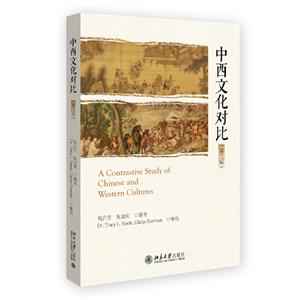-
>
中医基础理论
-
>
高校军事课教程
-
>
思想道德与法治(2021年版)
-
>
毛泽东思想和中国特色社会主义理论体系概论(2021年版)
-
>
中医内科学·全国中医药行业高等教育“十四五”规划教材
-
>
中医诊断学--新世纪第五版
-
>
中药学·全国中医药行业高等教育“十四五”规划教材
中西文化对比(第二版) 版权信息
- ISBN:9787301345146
- 条形码:9787301345146 ; 978-7-301-34514-6
- 装帧:平装
- 册数:暂无
- 重量:暂无
- 所属分类:>>
中西文化对比(第二版) 本书特色
本书从跨文化交际案例入手,对中西方文化差异展开全面而审慎的研究和思考:**版教材于2016年出版,本次修订再版新增若干真实原创案例。如有关Empathy的案例,Stereotype的案例,西方“向中国追责索赔”的案例“中西发展模式”这一案例。同时,删除若干过时的案例,如Unit 10中有关classification的案例,Unit 11中有关controlling的案例。
中西文化对比(第二版) 内容简介
这是一部以本科生和研究生为主要对象、专门比较传统中西文化的“中西文化对比”课程英语教材。教材共分五个部分:I、传统上的“东”与“西”(相当于绪论);II、无声语言差异与传统文化差异;III、思维差异与传统文化差异;IV、不同的传统价值观;V、不同的文化本位,适用于高等院校的英语专业本科生公共选修课程及英语专业学术型研究生选修课程,有利于培养学生的文化差异意识、文化差异敏感性、跨文化交际能力及中国文化传播能力。
中西文化对比(第二版) 目录
Part I.East and West
Unit 1 .Why Contrasting Chinese and Western Cultures?.................3
I. Ancient Civilizations and Cultures ................................................................3
II. Cross-cultural Comparative Studies in China ..............................................5
III. Imperatives to Contrast Chinese and Western Cultures ..............................9
IV. A Note on Some Key Concepts .................................................................15
Unit 2 .Characteristics of Traditional Chinese and Western Cultures..............19
I. “There Are All Kinds of Birds in a Large Forest” .......................................19
II. Traditional Chinese Cultural Characteristics ............................................22
III. Traditional Western Cultural Characteristics ............................................32
Unit 3 .Affinities Across Cultures........................................................37
I. Two Unexpected Affinities ..........................................................................38
II. Reading for More Cultural Affinities .........................................................39
III. A Note on Some Key Concepts ................................................................51
Part II Cultural Differences in Silent Language
Unit 4 .Time .........................................................................................59
I. Time in China and the West .........................................................................60
II. Two Time Modes ........................................................................................65
III. Past-oriented Societies vs. Future-oriented Societies ...............................73
IV. Two Time Orientations ..............................................................................76
Unit 5 .Space ........................................................................................80
I. What Is Space? ............................................................................................81
II. Spatial Language ........................................................................................82
III. Spatial Language and Culture ...................................................................86
IV. Spatial Language and Life ........................................................................93
Unit 6 .Smiles, Nods and Silence ........................................................97
I. Smiles in Intercultural Communication ......................................................97
II. Nods in Intercultural Communication ......................................................103
III. Silence in Intercultural Communication .................................................105
Part III Cultural Differences in Thinking
Unit 7 .Intuitive vs. Logical Thinking..............................................115
I. Definitions of Intuitive and Logical Thinking ............................................116
II. Philosophy and Thinking ..........................................................................117
III. Application of the Two Thinking Modes ................................................121
IV. Impact of Thinking Modes on Writings ..................................................126
V. Logic in China and Intuition in the West ..................................................128
Unit 8 .Dialectical vs. Analytical Thinking......................................132
I. Proverb Preferences Across Cultures ........................................................133
II. Dialectical Thinking .................................................................................134
III. Analytical Thinking ................................................................................139
IV. More about the Two Modes ....................................................................143
Unit 9 .Holistic vs. Atomistic Visions ...............................................146
I. A Detention Room Incident .......................................................................147
II. Prominent Attributes of Holistic and Atomistic Visions ..........................147
III. Vision and Cognition ..............................................................................156
IV. Vision and Language ...............................................................................157
V. Zhengshan Xiaozhong and Lipton Black Tea ..........................................164
Unit 10 .Categorizing Objects by Relationships vs. by Attributes.....167
I. Two Ways to Categorize Objects ...............................................................168
II. Principles to Categorize Objects ..............................................................169
III. How to Categorize Objects and Why .....................................................172
IV. Impacts of Different Ways of Categorization ..........................................175
V. Causal Attribution Patterns Caused by Different Categorization Ways ......178
Unit 11 .Non-controllers vs. Controllers .........................................182
I. Too Early to Tell ........................................................................................183
II. Why So Different Stances Towards Life? ................................................184
III. “Being” and “Doing” Cultures ...............................................................190
IV. Manifestations of “Being” Culture and “Doing” Culture .......................194
Part IV Different Cultural Orientations
Unit 12 .The Introvert-oriented vs. the Extrovert-oriented...........205
I. Personality Types .......................................................................................206
II. Personality Types of Cultures ..................................................................208
III. Effects of Personality Types on Pattern Preferences ...............................213
IV. A Contrast of Some Cultural Phenomena ...............................................219
Unit 13 .Collectivism vs. Individualism...........................................225
I. An Embarrassing Custom ..........................................................................225
II. Collectivism and Individualism as Cultural Orientations ........................227
III. Collectivism and Individualism in Cultural Anthropology ....................233
IV. Collectivist and Individualist Perspectives of “Self” ..............................236
V. Interdependence vs. Independence ...........................................................241
Unit 14 .Advocacy of Jing vs. Dong......................................................245
I. Introduction to Two Concepts ...................................................................246
II. Chinese Advocacy of Jing ........................................................................248
III. Western Advocacy of Dong ....................................................................258
IV. Differences and Discomforts ...................................................................263
Unit 15 .Implicitness vs. Explicitness ..............................................267
I. “Half a Story” ............................................................................................268
II. Implicitness vs. Explicitness of Language ...............................................270
III. Implicit Traditional Chinese ...................................................................276
IV. Explicit Westerners .................................................................................284
V. High-context vs. Low-context ..................................................................287
VI. “Chicken and Duck Talk” .......................................................................291
Part V Different Cultural Standards
Unit 16 .Peace vs. Conflict ................................................................299
I. Great Names and Different Cultural Standards .........................................300
II. External Factors and Cultural Standards ..................................................305
III. Cultural Standards and Their Unique Products ......................................308
IV. Better Ways to Know Each Other ...........................................................313
Unit 17 .Egalitarian vs. Inegalitarian Distribution .......................316
I. Hate-the-rich Mentality .............................................................................316
II. Traditional Chinese-style Egalitarianism .................................................318
III. Western-style Inegalitarianism ................................................................321
IV. Egalitarianism and Inegalitarianism in China and the West ...................323
Unit 18 .Good vs. Evil Human Nature ............................................326
I. Definition of Two Concepts .......................................................................326
II. Human Nature and Education ..................................................................328
III. Theorization of Assumptions about Human Nature ...............................331
IV. Human Nature Theories and the Rule of Ethics vs. Law ........................337
Unit 19 .Rule of Individuals vs. Rule of Law ..................................339
I. Rule of Individuals in Traditional Chinese Thought .................................339
II. Rule of Law in Traditional Western Thought ...........................................345
III. Rule of Law in China Today ...................................................................350
中西文化对比(第二版) 作者简介
祝吉芳,河海大学教授、河海大学学术委员会委员,长期从事英专本科及英专研究生的跨文化交际、中国文化概论、西方文化入门、中西文化对比、写作、翻译、文学翻译、翻译批评等课程教学。主要著作有:《冲突、碰撞与趋同下的中西文化》(第一版,北京大学出版社)、《英汉翻译:方法与试笔》(北京大学出版社,共三版)、《中国文化经典英语导读》(英语版)(河海大学出版社出版)等。
祝加贝,皖江工学院讲师,长期从事英语专业本科教学以及中西文化比较研究及翻译批评、文学翻译等教学和研究。
- >
龙榆生:词曲概论/大家小书
龙榆生:词曲概论/大家小书
¥13.0¥24.0 - >
二体千字文
二体千字文
¥14.0¥40.0 - >
企鹅口袋书系列·伟大的思想20:论自然选择(英汉双语)
企鹅口袋书系列·伟大的思想20:论自然选择(英汉双语)
¥6.3¥14.0 - >
伊索寓言-世界文学名著典藏-全译本
伊索寓言-世界文学名著典藏-全译本
¥9.3¥19.0 - >
巴金-再思录
巴金-再思录
¥14.7¥46.0 - >
烟与镜
烟与镜
¥14.4¥48.0 - >
李白与唐代文化
李白与唐代文化
¥8.9¥29.8 - >
小考拉的故事-套装共3册
小考拉的故事-套装共3册
¥36.7¥68.0





















